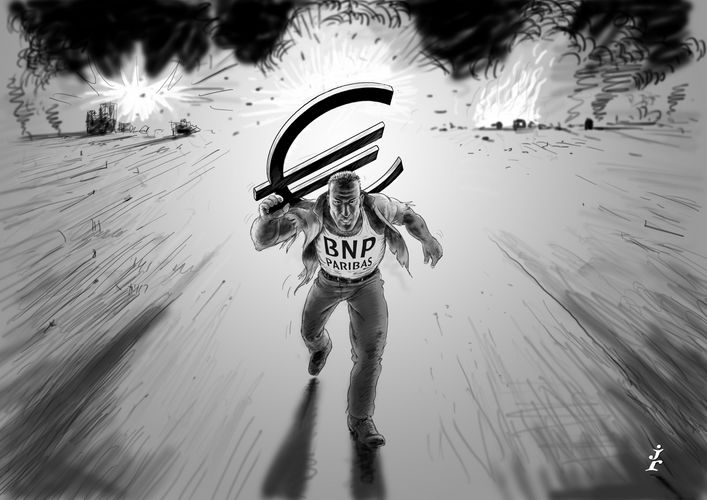Building on success: While there is no shortage of banks that can demonstrate credentials across certain asset classes within the single currency, few can claim to be able to offer expertise and a proven track record across the whole piece. BNP Paribas can, however, and for its comprehensive abilities it is IFR’s Euro Bond House of the Year.
To see the full digital edition of the IFR Review of the Year, please <a href="http://edition.pagesuite-professional.co.uk//launch.aspx?eid=24f9e7f4-9d79-4e69-a475-1a3b43fb8580" onclick="window.open(this.href);return false;" onkeypress="window.open(this.href);return false;">click here</a>.
It is always a difficult task to differentiate yourself in a market in which you have long held a prominent position. There is only so much more that you can offer and rivals will be forever be snapping at your heels with a view to seizing your crown.
BNP Paribas rose to that challenge in 2012, however, carving out a dominant position for itself across the diverse asset classes and structures within the euro sector and offering both buyside and sellside solutions.
“Our three watchwords were diligence, vigilance and excellence,” said Martin Egan, global head of primary markets and origination. “And we’ve delivered on all counts.”
The bank has long been viewed as being at the forefront of the corporate market and it continued to be a go-to house in a year that saw issuance double as bank lending lines gave way to bond market solutions.
A natural fit for French issuers, which again dominated with more than 20% of supply, BNPP still managed to grab around two-thirds of the mandates on offer, a notable achievement no matter what a bank’s provenance.
It was energy and power providers such as EDF and GDF Suez that really drove volumes in the sector, the latter pricing a €3bn three-tranche offering in May that took advantage of the low-rate environment and the company’s tight credit spreads to secure ultra-fine pricing but still attract a €7bn order book as investors looked for quality paper in uncertain times.
That deal ranked as the largest in euros since Merck’s €3.2bn transaction from March 2010 (also BNP Paribas-led).
Automotives coming to the fore
German borrowers also played a central role as far as issuance was concerned, at some 17% of overall supply.
Here it was the automotive sector that came to the fore with BMW, Daimler and Volkswagen among the most active and BNPP led benchmark deals for all three.
In addition to this, though, the year marked the return of rarer credits such as BASF and Deutsche Boerse and the French bank was once again on hand to execute transactions.
BNPP also helped Swiss issuers like Roche and Nestle take advantage of investors’ desire for some safe-haven paper in their portfolios while Philip Morris made its first appearance in the currency since March 2009 via a BNPP-led €1.35bn two-part seven and 12-year transaction that secured the lowest coupon rates in these maturities for a corporate issuer.
UK companies similarly took advantage of the distribution diversification on offer, with BNPP bringing a variety of deals to market, from the reintroduction of Compass to the hybrid offerings from BG and SSE.
On the M&A front, the bank helped AB InBev pre-finance its US$14bn acquisition of Grupo Mondelo with a €2.25bn three-trancher (the first since GDF), while also playing a key role in Glencore’s euro and sterling dual transaction.
BNPP was instrumental in organising an update call to apprise investors on the company’s plans regarding Xstrata and Viterra, while also advising on the use of a sub-investment grade step-up as well as a 50bp step were the Xstrata merger not completed prior to the first coupon date. This approach calmed investor nerves and ensured a successful exercise.
Peripheral Europe action
But it was perhaps peripheral Europe that attracted most headlines and BNPP Paribas was as active in this sphere as any other.
“It was nothing if not a crunch time for Europe,” said Christopher Marks, BNPP’s global head of debt capital markets. “It was largely played out through the market and we were able to offer neutral and unbiased advice.”
The bank lead-managed deals for Repsol, Iberdrola, Telefonica, Fiat, Telecom Italia, Snam, Eni, Enel and Portugal Telecom, to name but a few, not merely using the public wholesale institutional market but also taking advantage of its prowess within the private placement and retail spheres. That is one advantage it can exploit as “a domestic bank in a number of diverse jurisdictions”, said Egan.
Following TI’s dual-trancher in June that locked in favourable yields, it targeted €500m of a total nominal €2.3bn across four existing bonds in a buyback operation, one of a number of euro-denominated corporate liability management exercises BNPP was involved in.
Other examples of its credentials in this sector included Gasunie’s tender for up to €460m of its 6% October 2013 bond, announced simultaneously with a new €500m 10-year benchmark, Roche’s sole-led repeat cash tender offer on its 4.625% March 2013s and Hammerson’s tender on its 4.875% 2015s, which came about as a result of selling part of its London office portfolio and freeing up cash.
Public works
BNPP also continued to be a trusted partner for issuers in the public sector market, an arena that spent much of the year in a state of flux as a result of the problems within the eurozone.
While the bank made significant strides in other currencies, such as US dollars, which provided important pockets of demand for periods throughout the year, the euro market was the linchpin for many of its SSA borrowers, according to Robert Whichello, global co-head of syndicate. “For a vast part of the year, it was their only access,” he said.
Indeed, such is the esteem in which BNPP is held by Europe’s supranationals and agencies that it maintained a top four underwriting position across mandates from the EFSF, EIB, KfW and EU.
Aside from the usual shorter-dated trades, key among these were the more strategically important 30-year debut from the EU in January, priced at a difficult time in the market, and the EFSF’s 20 and 25-year benchmarks.
On the sovereign side of the equation, one notable achievement was its lead management position on Finland’s longest transaction to date – a €1.5bn 2.625% straight 30-year, which priced at 45bp over mid-swaps the same week as Austria ventured two years further down the curve at more than double the spread.
In the FIG sector, BNPP was able to “navigate the choppy waters across regulation, ratings, capital, liability management and senior debt”, according to Derry Hubbard, head of financial institutions syndicate.
“We have always been great in covered bonds but we also made progress overall through an advice-driven approach,” he said.
Indeed, the covered bond franchise continued at as impressive a pace as ever, although the year was more characterised by adaptability and insight – both of paramount importance amid balance sheet constraints and regulatory and ratings pressures.
Examples are the first ever S&P-compliant Tier 2 trade – from Danske Bank – and liability management exercises for the likes of HSH Nordbank, Jyske Bank and EFG International, on whose Tier 1 to Tier 2 exchange BNPP acted as sole dealer manager, offering the right balance of carrot and stick that is so important in delivering successful exercises.
Across exchange and switch offers, such as those for RBS and Banco Popolare, through to consent solicitations, such as that for EFG, but also for Cassa Depositi e Prestiti, Hypo-Alpe Adria and Oevag, BNPP ensured it maintained a seat at the top table of European LM.
But that is not to say that the bank was absent from the senior flow market, with many respected issuers trusting it with mandates in a market that has become increasingly important in demonstrating a borrower’s strength through access. Add to this credentials in the subordinated arena across both banks and insurance companies and it all adds up to a full-service package.
As Egan said: “We are Europe’s bookrunner; and we are Europe’s bookrunner across all the asset classes.”



